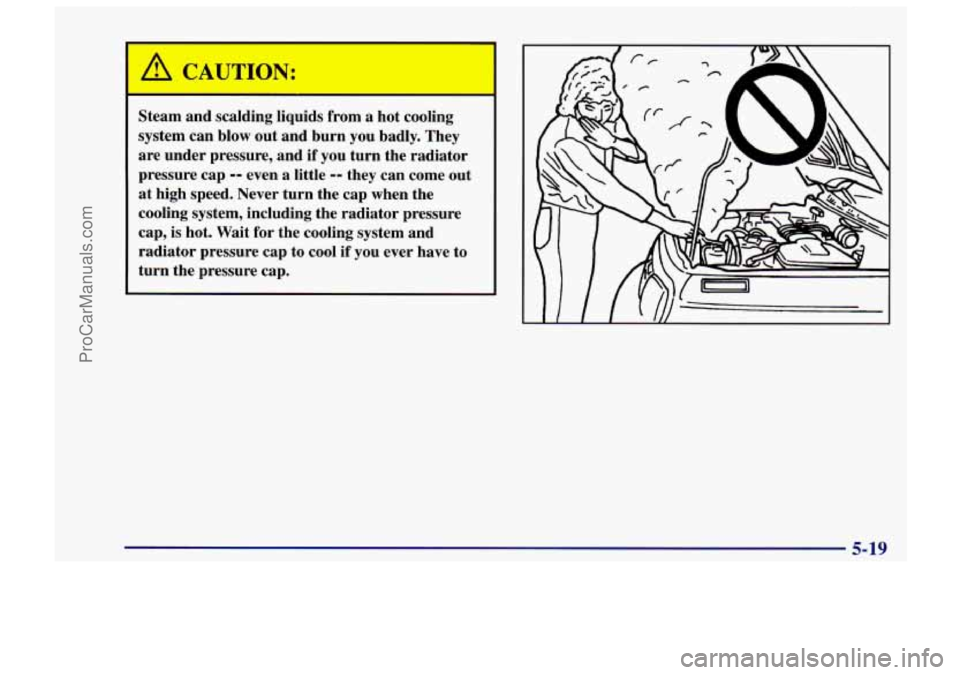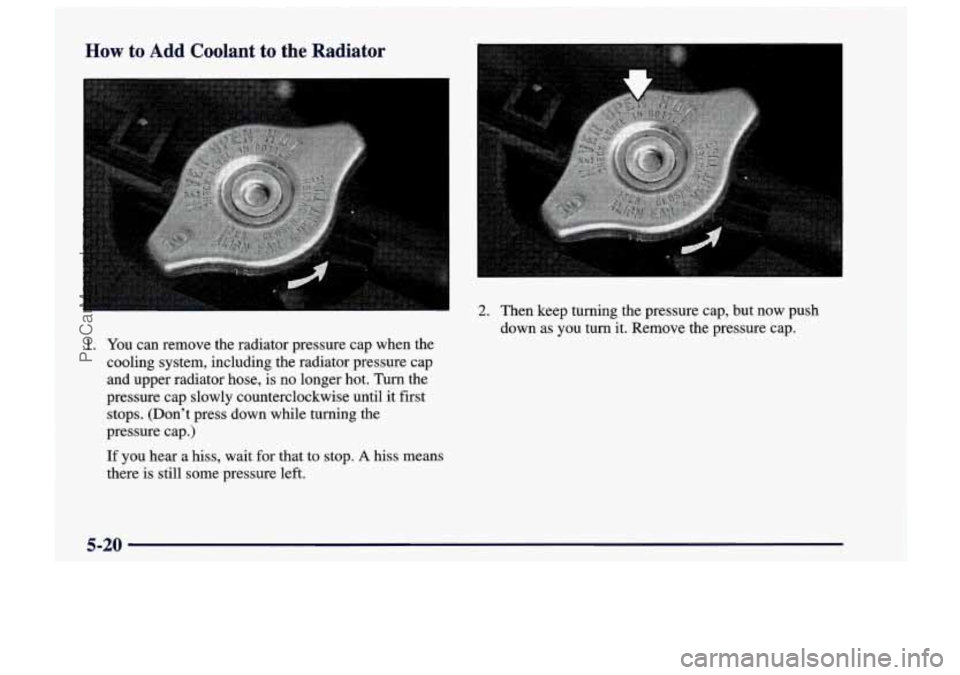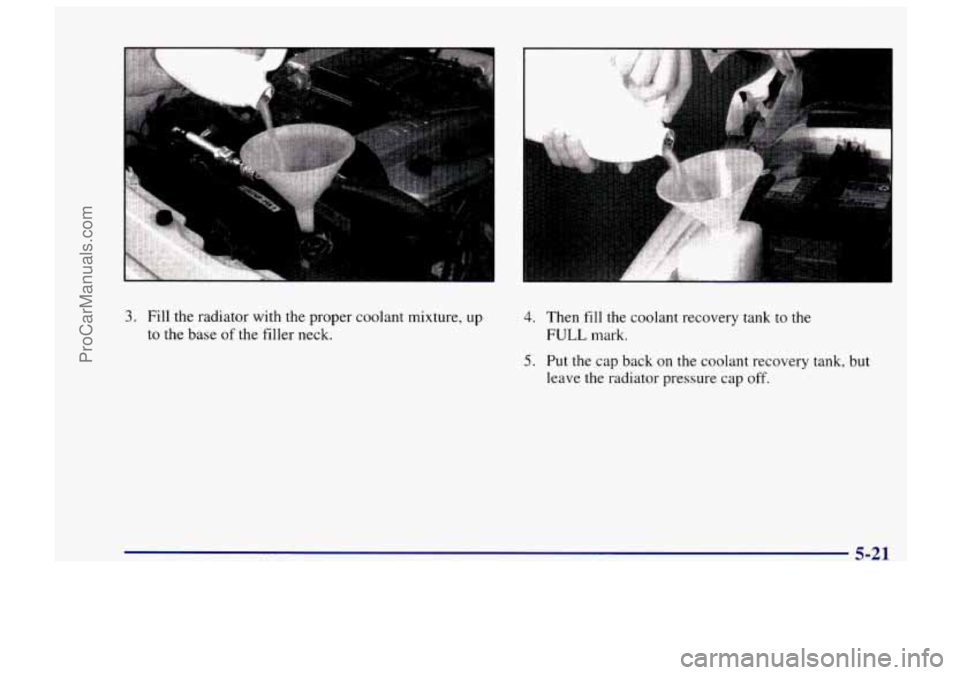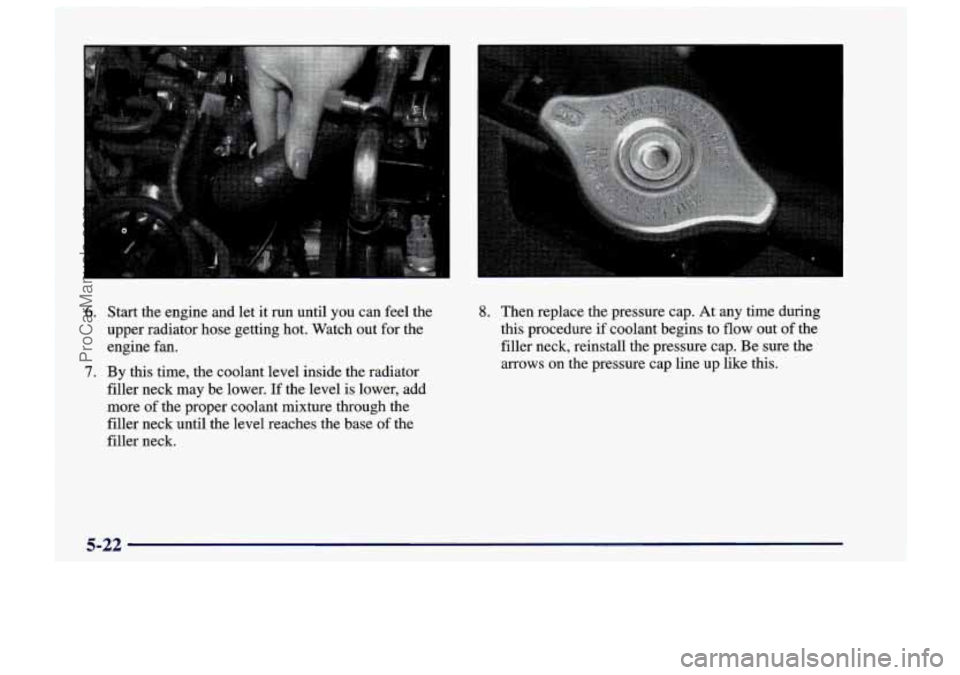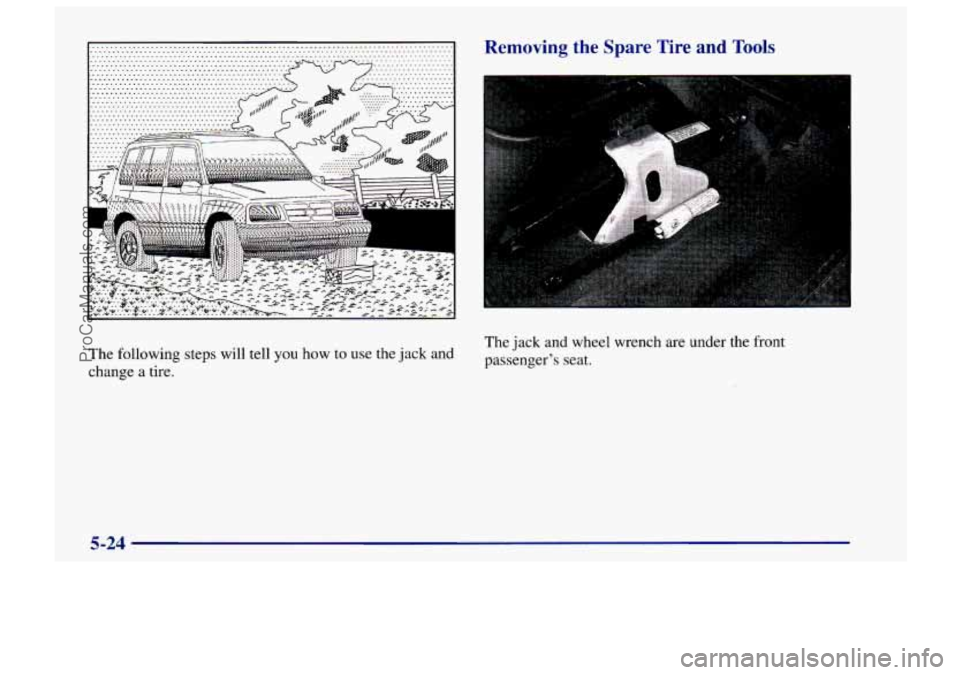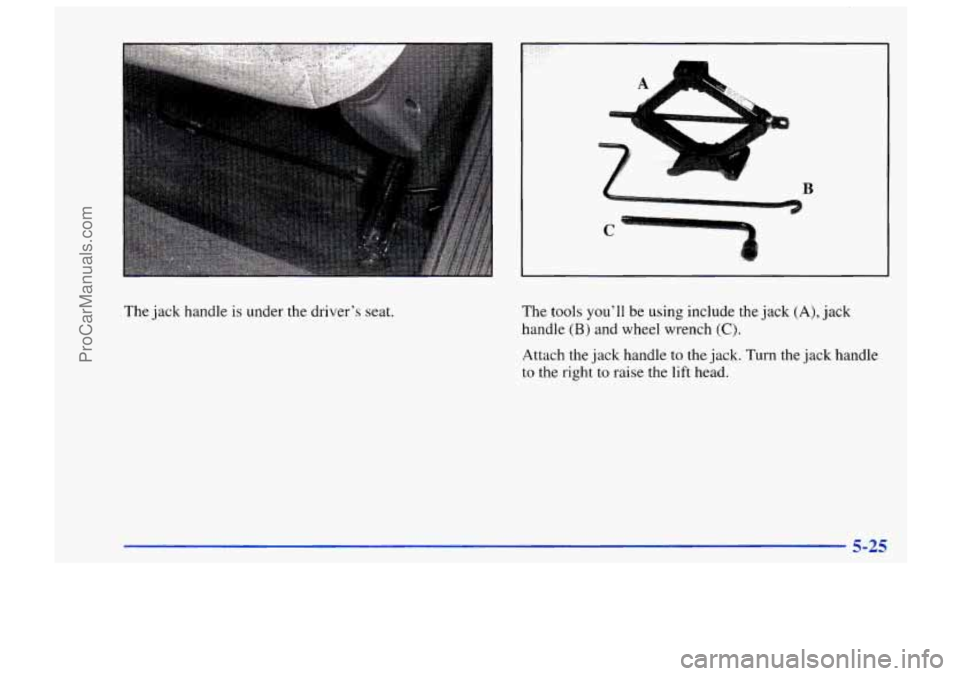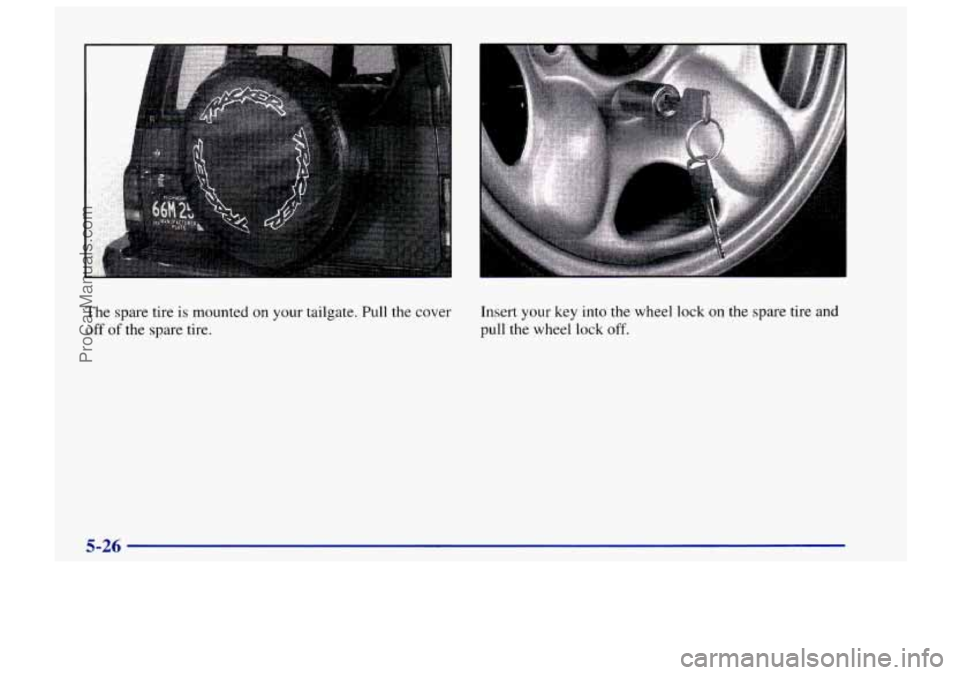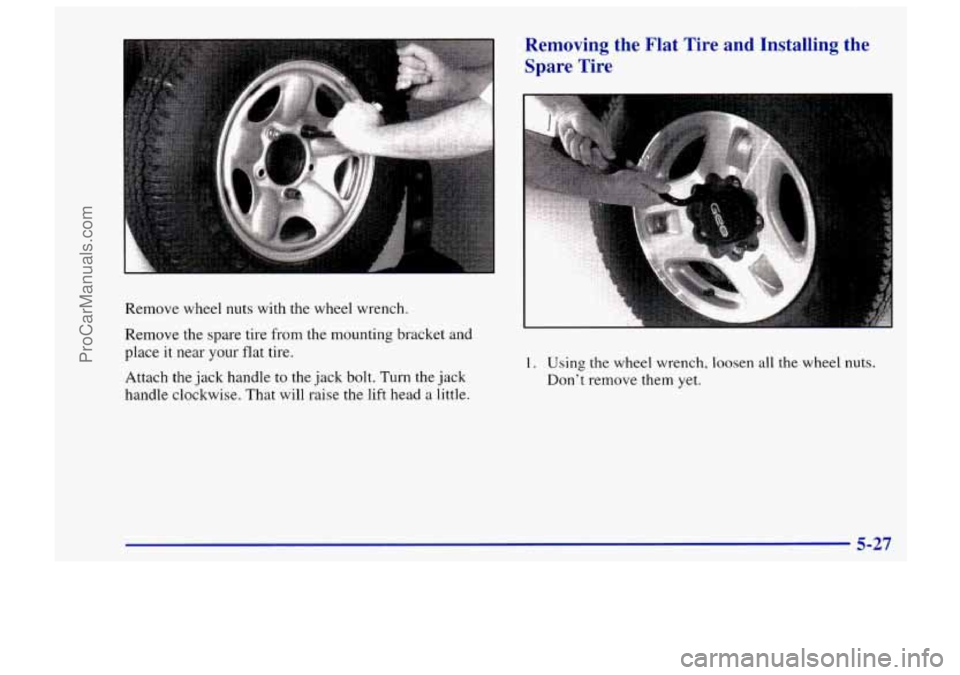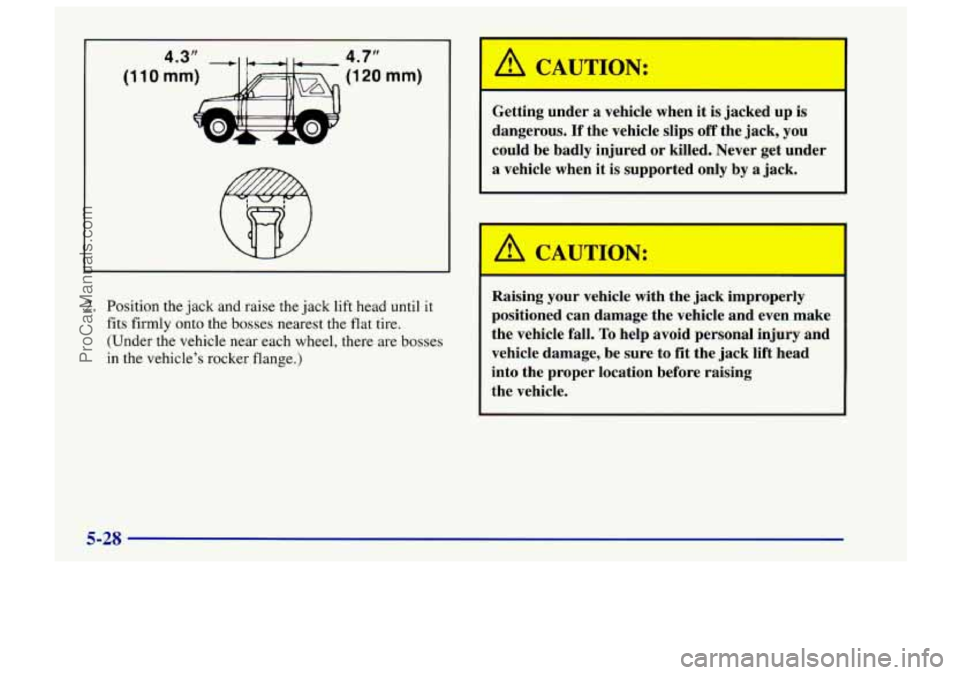CHEVROLET TRACKER 1997 Owners Manual
TRACKER 1997
CHEVROLET
CHEVROLET
https://www.carmanualsonline.info/img/24/57722/w960_57722-0.png
CHEVROLET TRACKER 1997 Owners Manual
Trending: change language, phone, oil dipstick, suspension, engine oil capacity, coolant, turn signal bulb
Page 221 of 388
Steam and scalding liquids from a hot cooling
system can blow out and burn you badly. They
are under pressure, and if you turn the radiator
pressure cap
-- even a little -- they can come out
at high speed. Never turn the cap when the
cooling system, including the radiator pressure
cap,
is hot. Wait for the cooling system and
radiator pressure cap to cool
if you ever have to
turn the pressure cap.
5-19
I
ProCarManuals.com
Page 222 of 388
How to Add Coolant to the Radiator
2. Then keep turning the pressure cap, but now push
down as you turn it. Remove the pressure cap.
1. You can remove the radiator pressure cap when the
cooling system, including the radiator pressure cap
and upper radiator hose, is no longer hot.
Turn the
pressure cap slowly counterclockwise until it first
stops. (Don’t press down while turning the
pressure cap.)
If you hear a
hiss, wait for that to stop. A hiss means
there is still some pressure left.
5-20
ProCarManuals.com
Page 223 of 388
3. Fill the radiator with the proper coolant mixture, up
to the base of the filler neck. 4. Then fill the coolant recovery tank to the
FULL mark.
5. Put the cap back on the coolant recovery tank, but
leave the radiator pressure cap off.
5-21
I
ProCarManuals.com
Page 224 of 388
6. Start the engine and let it run until you can feel the
upper radiator hose getting hot. Watch out for the
engine fan.
filler neck may be lower.
If the level is lower, add
more of
the proper coolant mixture through the
filler neck until the level reaches the base of the
filler neck.
7. By this time, the coolant level inside the radiator
8. Then replace the pressure cap. At any time during
this procedure
if coolant begins to flow out of the
filler neck, reinstall the pressure cap. Be sure the
arrows
on the pressure cap line up like this.
5-22
ProCarManuals.com
Page 225 of 388
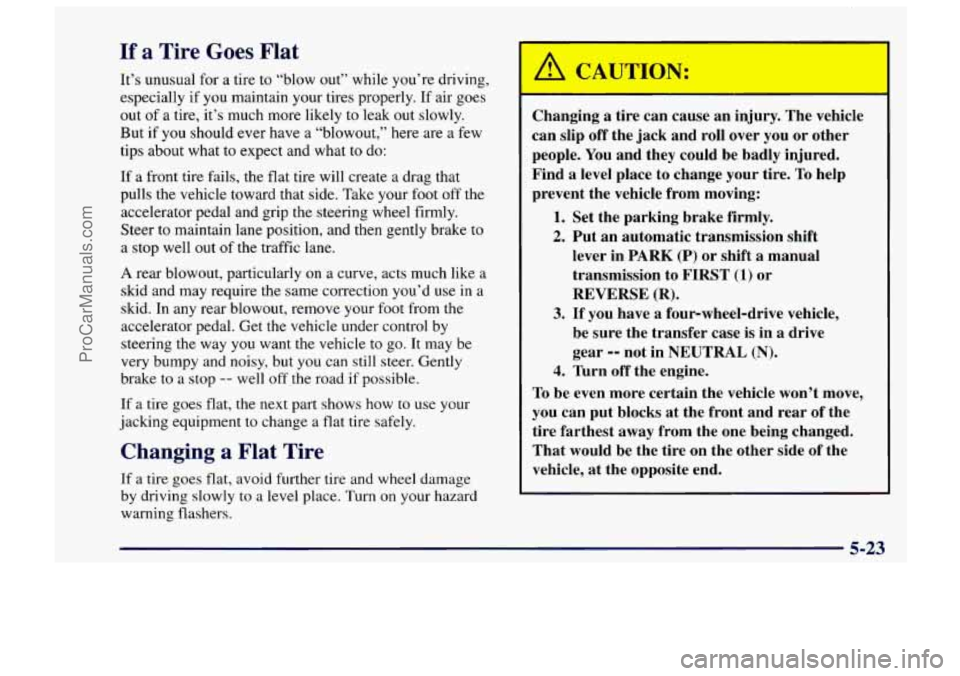
If a Tire Goes Flat
It’s unusual for a tire to “blow out’’ while you’re driving,
especially if you maintain your tires properly. If air goes
out of a tire, it’s much more likely to leak out slowly.
But if you should ever have a “blowout,” here are a few
tips about what to expect and what to do:
If a front tire fails, the flat tire will create a drag that
pulls the vehicle toward that side. Take your foot off the
accelerator pedal and grip the steering wheel firmly.
Steer to maintain lane position, and then gently brake to
a stop well out of the traffic lane.
A rear blowout, particularly on a curve, acts much like a
skid and may require the same correction you’d
use in a
skid. In any rear blowout, remove your foot from the
accelerator pedal. Get the vehicle under control
by
steering the way you want the vehicle to go. It may be
very bumpy and noisy, but you can still steer. Gently
brake
to a stop -- well off the road if possible.
If a tire goes flat, the next part shows how to use your
jacking equipment to change a flat tire safely.
Changing a Flat Tire
If a tire goes flat, avoid further tire and wheel damage
by driving slowly
to a level place. Turn on your hazard
warning flashers.
Changing a tire can cause an injury. T vehicle
can slip off the jack and roll over you or other
people. You and they could be badly injured.
Find
a level place to change your tire. To help
prevent the vehicle from moving:
1. Set the parking brake firmly.
2. Put an automatic transmission shift
lever in
PARK (P) or shift a manual
transmission to FIRST
(1) or
REVERSE (R).
3. If you have a four-wheel-drive vehicle,
be sure the transfer case is in a drive
gear
-- not in NEUTRAL (N).
4. Turn off the engine.
To be even more certain the vehicle won’t move,
you can put blocks at the front and rear of the
tire farthest away from the one being changed.
That would be the tire on the other side of the
vehicle, at the opposite end.
ProCarManuals.com
Page 226 of 388
The following steps will tell you how to use the jack and
change a tire.
Removing the SDare Tire and Tools
The jack and wheel wrench are under the front
passenger's seat.
5-24
ProCarManuals.com
Page 227 of 388
B
C
The jack handle is under the driver’s seat.
The tools you’ll be using include the jack (A), jack
handle
(B) and wheel wrench (C).
Attach the jack handle to the jack. Turn the jack handle
to the right to raise the lift head.
5-25
I
ProCarManuals.com
Page 228 of 388
The spare tire is mounted on your tailgate. Pull the cover
off of the spare tire. Insert your
key
into the wheel lock on the spare tire and
pull the wheel lock
off.
5-26
ProCarManuals.com
Page 229 of 388
k
Remove wheel nuts with the wheel wrench.
Remove the spare tire from the mounting bracket and
place it near your flat tire.
Attach the jack handle to the jack bolt. Turn the jack
handle clockwise. That will raise the lift head
a little.
Removing the Flat Tire and Installing the
Spare Tire
I. Using the wheel wrench, loosen all the wheel nuts.
Don't remove them yet.
5-27
I
ProCarManuals.com
Page 230 of 388
4.7"
(1 20 mm)
2. Position the jack and raise the jack lift head until it
fits
firmly onto the bosses nearest the flat tire.
(Under the vehicle near each wheel, there are bosses
in the vehicle's rocker flange.)
A CAUTION:
Getting under a vehicle when it is jacked up is
dangerous.
If the vehicle slips off the jack, you
could be badly injured
or killed. Never get under
a vehicle when it is supported only by a jack.
A CAUTION:
Raising your vehicle with the jack improperly
positioned can damage the vehicle and even make
the vehicle fall.
To help avoid personal injury and
vehicle damage, be sure to fit the jack lift head
into the proper location before raising
the vehicle.
5-28
ProCarManuals.com
Trending: ESP, brake, service reset, cruise control, window, dead battery, fuel pump
